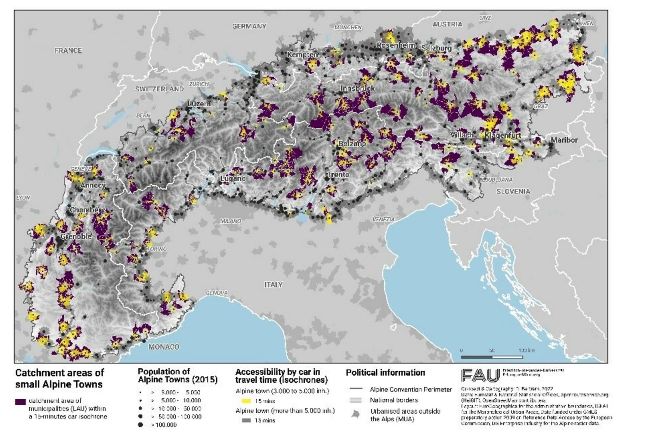Investigating roles beyond size: small towns in the European Alps

Dominik Bertram,

Tobias Chilla
Providing equitable access to services of general interest (SGI) is an explicit objective of the EU Territorial Agenda 2030. This aim is particularly challenging for territories with geographical specificities - such as mountain regions and islands that are sparsely populated as well as coastal areas. In these regions, the density of SGI is mostly lower than elsewhere. Especially in mountain regions, ensuring fair accessibility to SGI is a significant challenge due to low population density and topographical barriers.
Addressing mountain specificities
The ESPON Alps2050 project shows that the provision of services in the Alpine region is complex. The maps show travel times to doctors, primary schools, and railway stations. There is a significant difference in accessibility across the Alpine region, with a variation of factor of approximately ten between the highest and lowest values. From a policy perspective, it is important to note that hampered accessibility in mountain regions leads either to longer travel times or, more optimally, to a higher density of services in small places.
peripheral mountain areas are often highly car dependent.
Individuals without car access, often due to age, economic, or cultural barriers, are the most affected by limited accessibility.
In areas where demand is low and dispersed, conventional public transport services such as rail and bus systems are mostly inefficient. As a result, peripheral mountain areas are often highly car dependent. Individuals without car access, often due to age, economic, or cultural barriers, are the most affected by limited accessibility.
Many studies show that it is challenging to achieve the same level of service provision in territories with geographical specificities compared to metropolitan areas. However, in a balanced, polycentric settlement system, an adequate and acceptable standard of services can be attained.
Against this background, the discussion on settlement systems and accessibility arguments is of high interest in mountain regions. A polycentric spatial organisation of SGI is a key objective for sustainable spatial development. In this context, small towns have to provide key functions for their surrounding areas. The 9th Report on the State of the Alps identified 780 towns in the Alps as potential central places. This definition covers 60% of the population within the Alpine Convention perimeter. It is noteworthy that 161 of these Alpine towns have less than 5,000 inhabitants.
The 15-minute catchment areas comprise about 1.6 million inhabitants living in even smaller towns. This indicates that about 17% of the Alpine population live in small centres and their surroundings.
Potential roles beyond size: small towns in mountain areas
Mountain towns fulfil functions "beyond size": this means that settlements in mountain contexts tend to have functions that normally are provided by larger cities in non-mountainous regions.
The concept of population catchment intensities (PCI) provides a helpful perspective for Alpine spatial development. This approach, as visualised in the map, combines demographic and accessibility analyses. Within the inner-Alpine region, several small towns show extremely high PCI values. For example, a PCI value of 2 indicates a catchment area within a 15-minute drive with twice the number of inhabitants as the core settlement.

In total, about 630,000 people live in small Alpine towns. The 15-minute catchment areas comprise about 1.6 million inhabitants living in even smaller towns. This indicates that about 17% of the Alpine population live in small centres and their surroundings. Most small towns provide essential functions for their neighbouring regions. Many of them are involved in global networks and have a high prominence, due to their relevance for tourism (e.g. Sölden, Oberstdorf or Cortina d'Ampezzo), their political role (e.g. Davos, Vaduz or Monaco), or as headquarters of global companies (e.g. Reutte, Schaan).
Policy implications
In the Alps, the size of a settlement does not determine its urban functions. Small mountain towns often have to provide more functions than peri-Alpine suburban areas. Future policies could address this Alpine specificity to unlock the full potential of a pan-Alpine settlement system. The key question is what types of settlement system and urbanisation is most appropriate and sustainable.
Particularly in sparsely populated mountain areas, focusing on small towns bears a high potential for spatial planning and development. In the long run, spatial development based on accessibility arguments can significantly reduce travel times by car and other means of transport. Aiming for high efficiency of spatial organisation in the provision of SGI is an important facet of sustainable Alpine development.
Dominik Bertram & Pr. Dr. Tobias Chilla, Institute of Geography, University of Erlangen-Nuremberg, Erlangen, Germany